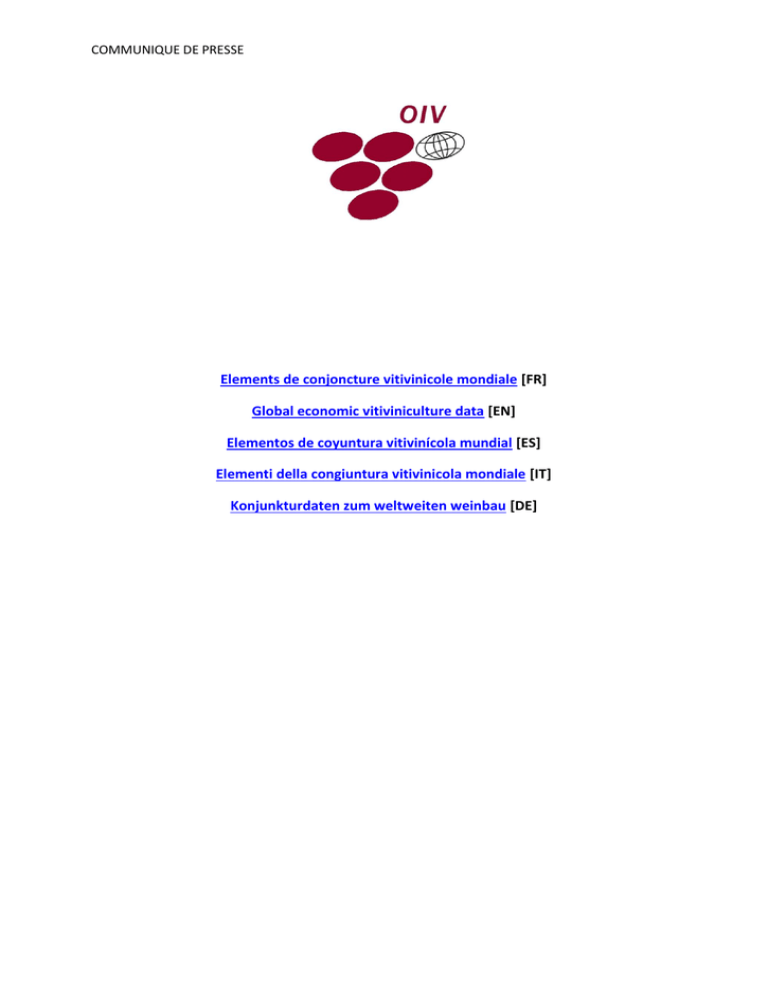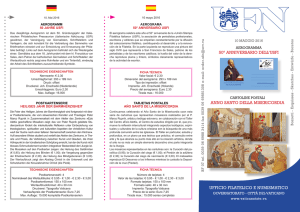Elements de conjoncture vitivinicole mondiale
Anuncio

COMMUNIQUE DE PRESSE Elements de conjoncture vitivinicole mondiale [FR] Global economic vitiviniculture data [EN] Elementos de coyuntura vitivinícola mundial [ES] Elementi della congiuntura vitivinicola mondiale [IT] Konjunkturdaten zum weltweiten weinbau [DE] COMMUNIQUE DE PRESSE Paris, 23 octobre 2014 ELEMENTS DE CONJONCTURE VITIVINICOLE MONDIALE 271 Mhl de vin produits en 2014 Avec une diminution de 6% par rapport à l’année précédente, la production mondiale de vin en 2014 retrouve un niveau moyen, mais avec des évolutions contrastées. L’année a été marquée par de forts aléas climatiques qui sont à l’origine de ces évolutions, notamment en Europe. o La France redevient le 1er producteur mondial (46,2 Mhl), devant l’Italie qui connait une faible récolte (44,4 Mhl) o L’Espagne retrouve un niveau moyen de production (37 Mhl) après une année record en 2013 o Bon niveau de production aux Etats-Unis (22,5 Mhl) pour la 3ème année consécutive o Recul sensible de la production au Chili (10 Mhl) et dans plusieurs pays d’Europe de l’Est o Record de production en Nouvelle Zélande (3,2 Mhl) et forte progression en Allemagne (9,7 Mhl) Lors de la conférence de presse qui s’est tenue au siège de l’Organisation Internationale de la Vigne et du Vin, le directeur général de l’OIV, Jean-Marie Aurand, a présenté les premiers éléments d’information sur la production viticole mondiale en 2014. La production mondiale de vin, hors jus et moûts, atteindrait 271 millions d'hectolitres, en recul de 6% par rapport à 2013, selon les premières estimations de l’OIV pour 2014. M. Aurand a précisé que les données 2013 ont été révisées à la hausse (287,6 Mhl) en raison de la vinification des moûts de raisins mis en réserve notamment en Italie et en Espagne. COMMUNIQUE DE PRESSE A quelques semaines de l’ouverture du Congrès Mondial de la Vigne et du Vin que se tiendra à Mendoza en Argentine (9-14 novembre 2014), le directeur général de l’OIV a également souligné la consolidation de consommation mondiale estimée, à ce stade, à 243Mhl. Evolution de la production mondiale de vin Mhl Production mondiale de vins (hors jus & moûts) 400 350 300 271 Mhl 250 200 150 100 2000 2001 2002 2003 2004 2005 2006 2007 2008 2009 2010 2011 2012 2013 Prév. 2014 La France redevient le premier producteur mondial (46,2 Mhl, + 10% par rapport à 2013), l’Italie enregistre une faible production (44,4 Mhl, -15% par rapport à 2013) et l’Espagne retrouve un niveau moyen de production (37 Mhl), après une année record (plus de 45 Mhl en 2013). On mentionnera la forte progression de la production en Allemagne (9,7 Mhl, +16%) La diminution des productions a été amplifiée dans les pays de l’Est de l’Europe : Bulgarie, Roumanie et Slovaquie enregistrent des reculs significatifs de leur production vinifiée relativement à 2013 (respectivement -30, -20 et -16%), en lien avec des conditions climatiques particulièrement défavorables. Seule la Hongrie maintiendrait son niveau de production 2013 en 2014 à 2,7 Mhl. Ailleurs dans l’UE, les évolutions sont généralement à la baisse, comme en Croatie (-30%/2013, avec une production légèrement inferieure à 1 Mhl) ou dans une moindre mesure au Portugal et en Grèce avec respectivement 5,9 Mhl (-6%/ 2013) et 2,9 Mhl (-13%/ 2013). Les Etats-Unis enregistreraient, pour la troisième année consécutive, un niveau de production élevé, et ce malgré les effets négatifs du tremblement de terre d’août et des conditions climatiques peu favorables en septembre en Californie. La production 2014 serait d’environ 22,5 Mhl. Dans l’Hémisphère Sud on observe des évolutions contrastées : le Chili se retrouve, après les 2 années records de 2012 et 2013, avec un recul de sa production conséquent: -2,8 Mhl (22%/2013) mais se maintiendrait à 10 Mhl, tandis qu’en Argentine la production vinifiée COMMUNIQUE DE PRESSE progresse légèrement : 15,2 Mhl (+1%/2013). L’Afrique du Sud obtiendrait quant à elle une production vinifiée de 11,4 Mhl (+4% par rapport à 2013). En Océanie, la production 2014 de la Nouvelle-Zélande attendrait un nouveau record en approchant les 3,2 Mhl (+29% par rapport au précédent record 2013 : 2,5 Mhl), tandis qu’en Australie, la production de 2014 s’inscrirait en légère progression par rapport à celle de 2013 (12,6Mhl contre 12,3 Mhl). La production de vins 2014 dans les dix principaux producteurs Vers une consolidation de la consommation A cette période de l’année, on ne dispose pas encore d’informations complètes sur le niveau de consommation des différents marchés, mais les éléments disponibles laissent entrevoir la poursuite de la consolidation de la consommation mondiale, autour de 243 Mhl. Dans ce contexte la production 2014 devrait permettre d’assurer la couverture de la consommation et des besoins de vins pour les usages industriels (Brandy, vinaigre, vermouth). COMMUNIQUE DE PRESSE Tableau 1: Production de vin (hors jus et moûts) (1) 1000 hl France Italie Espagne Etats-Unis (2) Argentine Australie Chine (3) Afrique du Sud Chili Allemagne Portugal Roumanie Nouvelle-Zélande Grèce Brésil Hongrie Autriche Bulgarie Suisse Croatie Total Mondial OIV (4) 2010 44 381 48 525 35 353 20 890 16 250 11 420 13000 9 327 8844 6 906 7 148 3 287 1 900 2 950 2 459 1 762 1 737 1 224 1 030 1 433 264 372 2011 50 757 42 772 33 397 19 140 15 473 11 180 13200 9 725 10464 9 132 5 622 4 058 2 350 2 750 3 460 2 750 2 814 1 237 1 120 1 409 267 243 2012 41 548 45 616 31 123 21 740 11 780 12 260 13810 10 568 12554 9 012 6 327 3 311 1 940 3 115 2 967 1 776 2 125 1 442 1 000 1 293 256 222 2013 42 004 52 429 45 650 23 500 14 984 12 310 11780 10 980 12 846 8 409 6 238 5 113 2 480 3 343 2 710 2 666 2 392 1 755 840 1 249 287 600 (1): Pays renseignés avec une production de vin superieure à 1 Mhl (2): Estimation OIV base USDA (3) : Report de l'année 2013, chiffre 2014 non encore disponible (4) Fourchette retenue pour la production mondiale 2014 266,2 Mhl à 275,5 Mhl 2014 46 151 44 424 37 000 22 500 15 200 12 560 11780 11 420 10 029 9 725 5886 4 093 3 200 2 900 2810 2 734 2 250 1 229 900 874 270 864 Variation 4147 -8005 -8650 -1000 216 250 0 440 -2817 1316 -352 -1020 720 -443 100 68 -142 -526 60 -375 -16736 Variation 10% -15% -19% -4% 1% 2% 0% 4% -22% 16% -6% -20% 29% -13% 4% 3% -6% -30% 7% -30% -6% Rang 1 2 3 4 5 6 7 8 9 10 11 12 13 14 15 16 17 18 19 20 COMMUNIQUE DE PRESSE Note pour les éditeurs: L'OIV est l'organisme intergouvernemental à caractère scientifique et technique de compétence reconnue dans le domaine de la vigne, du vin, des boissons à base de vin, des raisins de table, des raisins secs et des autres produits issus de la vigne. Il est composé de 46 États Membres. Dans le domaine de ses compétences, les objectifs de l'OIV sont les suivants : - Indiquer à ses membres les mesures permettant de tenir compte des préoccupations des producteurs, des consommateurs et des autres acteurs de la filière vitivinicole ; - Assister les autres organisations internationales intergouvernementales et non-gouvernementales, notamment celles qui poursuivent des activités normatives ; - Contribuer à l'harmonisation internationale des pratiques et normes existantes et, en tant que de besoin, à l'élaboration de normes internationales nouvelles, afin d'améliorer les conditions d’élaboration et de commercialisation des produits vitivinicoles et à la prise en compte des intérêts des consommateurs. *Abréviations: mhl : Milliers d’hectolitres Mhl - Millions d’hectolitres Contact : Pour plus d’informations, les journalistes sont invités à contacter le département de Communication de l’OIV l’adresse mail [email protected], ou par téléphone au +33 (0)1 44 94 80 92. Organisation Internationale de la Vigne et du Vin 18 rue d'Aguesseau 75008 Paris, France www.oiv.int COMMUNIQUE DE PRESSE Paris, 23 October 2014 GLOBAL ECONOMIC VITIVINICULTURE DATA 271 mhl of wine produced in 2014 With a reduction of 6% compared with the previous year, world wine production has returned to an average level in 2014, but with contrasting developments. The year has been marked by significant climatic hazards, which are at the root of these developments, particularly in Europe. o France has once again become the biggest producer in the world (46.2 mhl), ahead of Italy, which saw a poor harvest (44.4 mhl) o Spain has returned to an average level of production (37 mhl) after a record year in 2013 o Good level of production in the United States (22.5 mhl) for the 3rd consecutive year o Significant decline in production in Chile (10 mhl) and in several Eastern European countries o Record production on New Zealand (3.2 mhl) and high growth in Germany (9.7 mhl) During the press conference that was held at the headquarters of the International Organisation of Vine and Wine, the Director General of the OIV, Jean-Marie Aurand, presented initial information about world wine production in 2014. Global wine production, excluding juice and musts, is likely to reach 271 million hectolitres – a decrease of 6% compared with 2013, according to the OIV's early estimates for 2014. Mr Aurand specified that the 2013 data was revised upwards (287.6 mhl) due to wine made from the must of grapes held in reserve, particularly in Italy and Spain. With only a few weeks to go until the opening of the World Congress of Vine and Wine, which will be held in Mendoza, Argentina (9-14 November 2014), the Director General of the OIV also emphasised the consolidation of global consumption, which is at this stage estimated at 243 mhl. COMMUNIQUE DE PRESSE Trends in world wine production World wine production (excluding juice & musts) mhl 400 350 300 271 mhl 250 200 150 100 2000 2001 2002 2003 2004 2005 2006 2007 2008 2009 2010 2011 2012 2013 2014 Forecast France has once again become the biggest producer in the world (46.2 mhl, +10% compared with 2013), Italy has recorded a low production (44.4 mhl, -15% compared with 2013) and Spain has returned to an average level of production (37 mhl) following a record year (over 45 mhl in 2013). We should also mention the high growth in German production (9.7 mhl, +16%). This reduction in production has been amplified in Eastern European countries: Bulgaria, Romania and Slovakia have recorded significant declines in their vinified production in relation to 2013 (-30, -20 and -16% respectively), linked to particularly adverse climate conditions. Only Hungary has maintained its 2013 level of production in 2014 at 2.7 mhl. Elsewhere in the EU, there has been a general downward trend, as seen in Croatia (30%/2013) with a production of slightly less than 1 mhl, or to a lesser extent in Portugal and Greece with 5.9 mhl (-6%/2013) and 2.9 mhl (-13%/2013) respectively. For the third consecutive year, the United States has recorded a high level of production, despite the negative effects of the August earthquake and the not very favourable climate conditions in September in California. 2014 production is likely to be around 22.5 mhl. In the southern hemisphere, contrasting developments have been observed: Chile, after two record years in 2012 and 2013, has seen a decline in its sizeable production: -2.8 mhl (22%/2013) but likely to remain stable at 10 mhl, while in Argentina vinified production should grow slightly to 15.2 mhl (+1%/2013). As for South Africa, vinified production is likely to reach 11.4 mhl (+4% compared with 2013). In Oceania, New Zealand's 2014 production is likely to set a new record of nearly 3.2 mhl (+29% compared with the previous 2013 record of 2.5 mhl), while in Australia the 2014 production should see slight growth compared with that of 2013 (from 12.3 mhl to 12.6 mhl). COMMUNIQUE DE PRESSE 2014 wine production in the 10 main producing countries Moving towards consolidation of consumption At this time in the year, there is not yet comprehensive information on the level of consumption of different markets, yet the data available points to a consolidation of global consumption, at around 243 mhl. Under these circumstances, 2014 production should guarantee that consumption and the demand for wines for industrial uses (brandy, vinegar and vermouth) are covered. COMMUNIQUE DE PRESSE Table 1: Wine production (excluding juice and musts) (1) 1000 hl France Italy Spain United States (2) Argentina Australia China (3) South Africa Chile Germany Portugal Romania New Zealand Greece Brazil Hungary Austria Bulgaria Switzerland Croatia OIV World Total(4) 2010 44,381 48,525 35,353 20,890 16,250 11,420 13000 9,327 8844 6,906 7,148 3,287 1,900 2,950 2,459 1,762 1,737 1,224 1,030 1,433 264,372 2011 50,757 42,772 33,397 19,140 15,473 11,180 13200 9,725 10464 9,132 5,622 4,058 2,350 2,750 3,460 2,750 2,814 1,237 1,120 1,409 267,243 2012 41,548 45,616 31,123 21,740 11,780 12,260 13810 10,568 12554 9,012 6,327 3,311 1,940 3,115 2,967 1,776 2,125 1,442 1,000 1,293 256,222 2013 42,004 52,429 45,650 23,500 14,984 12,310 11780 10,980 12,846 8,409 6,238 5,113 2,480 3,343 2,710 2,666 2,392 1,755 840 1,249 287,600 2014 46,151 44,424 37,000 22,500 15,200 12,560 11780 11,420 10,029 9,725 5886 4,093 3,200 2,900 2810 2,734 2,250 1,229 900 874 270,864 (1): Countries for which information has been provided with a wine production of more than 1 mhl (2): OIV estimate (USDA basis) (3): Report for the year 2013, 2014 figures not yet available (4) Range used for 2014 world production: 266.2 mhl to 275.5 mhl 2014/2013 4147 -8005 -8650 -1000 216 250 0 440 -2817 1316 -352 -1020 720 -443 100 68 -142 -526 60 -375 -16736 2014/2013 10% -15% -19% -4% 1% 2% 0% 4% -22% 16% -6% -20% 29% -13% 4% 3% -6% -30% 7% -30% -6% Ranking 1 2 3 4 5 6 7 8 9 10 11 12 13 14 15 16 17 18 19 20 COMMUNIQUE DE PRESSE Note for editors: The OIV is the intergovernmental organisation of a scientific and technical nature of recognised competence for its work concerning vines, wine, wine-based beverages, table grapes, raisins and other vine-based products. It is composed of 46 Member States. In the framework of its competence, the objectives of the OIV are as follows: - to inform its members of measures whereby the concerns of producers, consumers and other players in the vine and wine products sector may be taken into consideration; - to assist other international organisations, both intergovernmental and non-governmental, especially those which carry out standardisation activities; - to contribute to international harmonisation of existing practices and standards and, as necessary, to the preparation of new international standards in order to improve the conditions for producing and marketing vine and wine products, and to help ensure that the interests of consumers are taken into account. *Abbreviations: khl: thousands of hectolitres mhl: millions of hectolitres Contact: for more information, journalists are invited to contact the Communications Department of the OIV by email at [email protected] or by telephone on +33 (0)1 44 94 80 92. International Organisation of Vine and Wine 18, Rue d’Aguesseau 75008 Paris, France www.oiv.int COMMUNIQUE DE PRESSE París, 23 de octubre de 2014 ELEMENTOS DE COYUNTURA VITIVINÍCOLA MUNDIAL 271 millones de hL de vino producidos en 2014 Con una disminución del 6 % en relación al año anterior, la producción mundial de vino en 2014 vuelve a un nivel medio, pero con evoluciones heterogéneas. El año ha estado signado por condiciones climáticas irregulares, que explican estas evoluciones, principalmente en Europa. o Francia vuelve a ocupar el puesto de primer productor mundial (46,2 Mill. hL), por delante de Italia que ha experimentado una cosecha escasa (44,4 Mill. hL). o España regresa a un nivel medio de producción (37 Mill. hL) tras un año récord en 2013. o Buen nivel de producción en Estados Unidos (22,5 Mill. hL) por tercer año consecutivo. o Notable retroceso de la producción en Chile (10 Mill. hL) y en numerosos países de Europa del Este. o Récord de producción en Nueva Zelanda (3,2 Mill. hL) y marcado progreso en Alemania (9,7 Mill. hL). Durante la conferencia de prensa que se llevó a cabo en la sede de la Organización Internacional de la Viña y el Vino, el director general de la OIV, Jean-Marie Aurand, presentó los primeros elementos informativos sobre la producción vitícola mundial en 2014. La producción mundial de vinos, excluyendo zumos y mostos, alcanzaría los 271 Mill. hL, un retroceso de un 6 % en relación a 2013, según las primeras estimaciones de la OIV para 2014. El director general de la Organización precisó que los datos de 2013 han sido revisados con una tendencia al alza (287,6 Mill. hL) debido a la vinificación de los mostos de uva que se encuentran en reserva, principalmente en Italia y España. COMMUNIQUE DE PRESSE A pocas semanas de la inauguración del Congreso Mundial de la Viña y el Vino que se celebrará en Mendoza, Argentina (del 9 al 14 de noviembre del corriente año), el director general de la OIV también destacó la consolidación del consumo mundial estimado, en este estadio, en 243 Mill. hL. Evolución de la producción mundial de vino Francia vuelve a ocupar el primer puesto como productor mundial (46,2 Mill. hL, + 10 % en relación a 2013), Italia registra una producción escasa (44,4 Mill. hL, - 15 % en relación a 2013) y España vuelve a un nivel medio de producción (37 Mill. hL), tras un año récord (más de 45 Mill. hL en 2013). Cabe destacar el marcado progreso de la producción en Alemania (9,7 Mill. hL, + 16 %). La disminución de la producción se ha visto intensificada en los países de Europa del Este: Bulgaria, Rumanía y Eslovaquia registran retrocesos significativos de su producción vinificada en relación a 2013 (respectivamente - 30, - 20 y - 16 %), lo que se vincula con condiciones climáticas particularmente desfavorables. Únicamente Hungría mantendría su nivel de producción de 2013 en 2014, en 2,7 Mill. hL. En otras partes de la UE, las evoluciones presentan una tendencia a la baja, como en Croacia (- 30 % / 2013, con una producción ligeramente inferior a 1 Mill. hL) o en menor medida en Portugal y en Grecia que cuentan, respectivamente, con 5,9 Mill. hL (- 6 % / 2013) y 2,9 Mill. hL (- 13 % / 2013). Estados Unidos registra, por tercer año consecutivo, un nivel de producción elevado, a pesar de los efectos negativos del terremoto de agosto y las condiciones climáticas poco favorables que se dieron en septiembre en California. La producción 2014 sería de alrededor de 22,5 Mill. hL. COMMUNIQUE DE PRESSE En el hemisferio sur, se observan evoluciones heterogéneas: Chile, tras dos años récord en 2012 y 2013, presenta una retracción de su considerable producción: -2,8 Mill. hL (- 22 % / 2013) pero se mantendría estable en 10 Mill. hL, mientras que en Argentina la producción vinificada experimenta un ligero progreso: 15,2 Mill. hL (+ 1 % / 2013). Sudáfrica, por su parte, obtendría una producción vinificada de 11,4 Mill. hL (+ 4 % en relación a 2013). En Oceanía, la producción 2014 de Nueva Zelanda alcanzaría un nuevo récord cercano a los 3,2 Mill. hL (+ 29 % en relación al récord anterior de 2013: 2,5 Mill. hL), mientras que en Australia, la producción de 2014 presentaría un ligero incremento en relación a la de 2013 (12,6 Mill. hL frente a 12,3 Mill. hL). La producción de vinos 2014 en los diez productores principales Hacia una consolidación del consumo En este periodo del año, no disponemos todavía de la información completa sobre el nivel de consumo de los diferentes mercados, pero los elementos disponibles permiten predecir un proseguimiento de la consolidación del consumo mundial, en torno a los 243 Mill. hL. En este contexto, la producción de 2014 debería permitir garantizar la cobertura del consumo y de la demanda de vino para usos industriales (aguardiente de vino, vinagre y vermú). COMMUNIQUE DE PRESSE Cuadro 1: Producción de vino (excluyendo zumos y mostos) 1 000 hL Francia Italia España Estados Unidos (2) Argentina Australia China (3) Sudáfrica Chile Alemania Portugal Rumanía Nueva Zelanda Grecia Brasil Hungría Austria Bulgaria Suiza Croacia Total mundial de la OIV (4) 2010 44.381 48.525 35.353 20.890 16.250 11.420 13000 9.327 8844 6.906 7.148 3.287 1.900 2.950 2.459 1.762 1.737 1.224 1.030 1.433 264.372 2011 50.757 42.772 33.397 19.140 15.473 11.180 13200 9.725 10464 9.132 5.622 4.058 2.350 2.750 3.460 2.750 2.814 1.237 1.120 1.409 267.243 (1) 2012 41.548 45.616 31.123 21.740 11.780 12.260 13810 10.568 12554 9.012 6.327 3.311 1.940 3.115 2.967 1.776 2.125 1.442 1.000 1.293 256.222 2013 42.004 52.429 45.650 23.500 14.984 12.310 11780 10.980 12.846 8.409 6.238 5.113 2.480 3.343 2.710 2.666 2.392 1.755 840 1.249 287.600 (1): Países incluidos en el informe con una producción de vino superior a 1 Mill. hL (2): Estimación OIV (base USDA) (3): Informe del año 2013, cifras 2014 todavía no disponible (4): Horquilla estimada para la producción mundial 2014: 266,2 Mill. hL a 275,5 Mill. hL 2014 46.151 44.424 37.000 22.500 15.200 12.560 11780 11.420 10.029 9.725 5886 4.093 3.200 2.900 2810 2.734 2.250 1.229 900 874 270.864 Variación 4147 -8005 -8650 -1000 216 250 0 440 -2817 1316 -352 -1020 720 -443 100 68 -142 -526 60 -375 -16736 Variación 10% -15% -19% -4% 1% 2% 0% 4% -22% 16% -6% -20% 29% -13% 4% 3% -6% -30% 7% -30% -6% Puesto 1 2 3 4 5 6 7 8 9 10 11 12 13 14 15 16 17 18 19 20 COMMUNIQUE DE PRESSE Nota para los editores: La OIV es el organismo intergubernamental de carácter científico y técnico, con una competencia reconocida en el campo de la viña, el vino, las bebidas a base de vino, las uvas de mesa, las uvas pasas y otros productos derivados de la vid. Está compuesta por 46 Estados miembros. Dentro del campo de sus competencias, los objetivos de la OIV son los siguientes: - indicar a sus miembros las medidas que permitan tener en cuenta las preocupaciones de los productores, de los consumidores y de los otros actores del sector vitivinícola; - asistir a las otras organizaciones internacionales intergubernamentales y no gubernamentales, especialmente a aquellas que ejercen actividades normativas; - contribuir a la armonización internacional de las prácticas y normas existentes y, cuando sea necesario, a la elaboración de nuevas normas internacionales a fin de mejorar las condiciones de elaboración y comercialización de los productos vitivinícolas, tomando en cuenta los intereses de los consumidores. *Abreviaturas: mhL: miles de hectolitros Mill. hL: millones de hectolitros Contacto: por más información, se invita a los periodistas a contactarse con el Departamento de Comunicación de la OIV a la dirección de correo electrónico [email protected], o por teléfono al +33 (0)1 44 94 80 92. Organización Internacional de la Viña y el Vino 18, rue d’Aguesseau 75008 París, Francia www.oiv.int COMMUNIQUE DE PRESSE Parigi, giovedì 23 ottobre 2014 ELEMENTI DELLA CONGIUNTURA VITIVINICOLA MONDIALE 271 Mio hl di vino prodotti nel 2014 Con una flessione del 6% rispetto all'anno precedente, la produzione mondiale di vino nel 2014 ritorna a un livello medio, ma con evoluzioni contrastanti. L'annata è stata segnata da forti avversità climatiche che sono all'origine di tali evoluzioni, in particolare in Europa. o La Francia diventa nuovamente il primo produttore mondiale (46,2 Mio hl), davanti all’Italia, che registra un raccolto scarso (44,4 Mio hl) o La Spagna ritrova un livello di produzione medio (37 Mio hl) dopo un'annata record nel 2013 o Buon livello di produzione negli Stati Uniti (22,5 Mio hl) per il terzo anno consecutivo o Calo sensibile della produzione in Cile (10 Mio hl) e in diversi paesi dell'Europa orientale o Produzione record in Nuova Zelanda (3,2 Mio hl) e forte aumento in Germania (9,7 Mio hl) Durante la conferenza stampa che si è tenuta presso la sede dell'Organizzazione internazionale della vigna e del vino, il direttore generale, Jean-Marie Aurand, ha presentato le prime informazioni disponibili sulla produzione vitivinicola mondiale nel 2014. Secondo le prime stime dell'OIV per il 2014, la produzione mondiale di vino, esclusi succhi e mosti, arriverebbe a 271 milioni di ettolitri, con un calo del 6% rispetto al 2013. Aurand ha specificato che i dati relativi al 2013 sono stati rivisti al rialzo (287,6 Mio hl), data la vinificazione dei mosti d'uva messi in riserva, in particolare in Italia e in Spagna. A poche settimane dall'apertura del Congresso mondiale della vigna e del vino, che si terrà a Mendoza, in Argentina (dal 9 al 14 novembre 2014), il direttore generale dell'OIV ha messo in evidenza anche il consolidamento del consumo mondiale, stimato allo stato attuale in 243 Mio hl. COMMUNIQUE DE PRESSE Evoluzione della produzione mondiale di vino La Francia torna al primo posto tra i produttori del mondo (46,2 Mio hl, +10% rispetto al 2013), l’Italia registra una produzione scarsa (44,4 Mio hl, -15% rispetto al 2013) e la Spagna torna a un livello di produzione medio (37 Mio hl) dopo un'annata record (oltre 45 Mio hl nel 2013). Va menzionata anche la forte crescita della produzione in Germania (9,7 Mio hl, +16%). Il calo delle produzioni si amplifica nei paesi dell'Europa orientale: Bulgaria, Romania e Slovacchia registrano flessioni significative della produzione vinificata rispetto al 2013 (rispettivamente -30, -20 e -16%), a causa di condizioni climatiche particolarmente sfavorevoli. Solo l'Ungheria mantiene il livello di produzione 2013 anche nel 2014, con 2,7 Mio hl. Altrove nell'UE, le tendenze sono generalmente al ribasso, come in Croazia (30%/2013, con una produzione leggermente inferiore a 1 Mio hl) o, in misura minore, in Portogallo e in Grecia, con 5,9 Mio hl (-6%/2013) e 2,9 Mio hl (-13%/2013) rispettivamente. Per il terzo anno consecutivo, gli Stati Uniti registrano un livello di produzione elevato, e ciò nonostante gli effetti negativi del terremoto di agosto e le condizioni climatiche avverse avutesi a settembre in California. La produzione 2014 è di circa 22,5 Mio hl. Nell'emisfero australe si osservano evoluzioni contrastanti: il Cile, dopo due annate record nel 2012 e 2013, assiste a un calo della sua considerevole produzione: -2,8 Mio hl (-22%/2013), ma si manterrebbe stabile a 10 Mio hl, mentre in Argentina la produzione vinificata cresce leggermente: 15,2 Mio hl (+1%/2013). Il Sud Africa raggiungerebbe una produzione vinificata di 11,4 Mio hl (+4% rispetto al 2013). In Oceania, la produzione 2014 della Nuova Zelanda stabilirebbe un nuovo record, raggiungendo i 3,2 Mio hl (+29% rispetto al record precedente 2013: 2,5 Mio hl), mentre in COMMUNIQUE DE PRESSE Australia la produzione 2014 sembra marcare una leggera crescita rispetto a quella del 2013 (12,6 Mio hl rispetto a 12,3 Mio hl). La produzione di vini 2014 nei dieci paesi produttori principali I dieci produttori principali producono oltre l’80% Francia 46 Mio hl Stati Uniti 22,5 Mio hl Spagna 37 Mio hl Germania 9,7 Mio hl Cina* 12 Mio hl Italia 44,4 Mio hl Cile 10 Mio hl Argentina 15,2 Mio hl Sud Africa 11,4 Mio hl Australia 12,6 Mio hl *Relazione per il 2013, dati del 2014 non ancora disponibili Verso un consolidamento del consumo In questo periodo dell'anno non disponiamo ancora di informazioni complete sui livelli di consumo dei diversi mercati, ma gli elementi a disposizione lasciano intravedere il proseguimento del consolidarsi del consumo mondiale intorno ai 243 Mio hl. In questo contesto, la produzione 2014 dovrebbe consentire di soddisfare la domanda di vino sia per il consumo sia per fini industriali (brandy, aceto e vermut). COMMUNIQUE DE PRESSE Tabella 1: Produzione di vino (esclusi succhi e mosti) (1) 1000 hl Francia Italia Spagna Stati Uniti (2) Argentina Australia Cina (3) Sud Africa Cile Germania Portogallo Romania Nuova Zelanda Grecia Brasile Ungheria Austria Bulgaria Svizzera Croazia Totale mondiale OIV (4) 2010 44.381 48.525 35.353 20.890 16.250 11.420 13.000 9.327 8844 6.906 7.148 3.287 1.900 2.950 2.459 1.762 1.737 1.224 1.030 1.433 264.372 2011 50.757 42.772 33.397 19.140 15.473 11.180 13.200 9.725 10464 9.132 5.622 4.058 2.350 2.750 3.460 2.750 2.814 1.237 1.120 1.409 267.243 2012 41.548 45.616 31.123 21.740 11.780 12.260 13.810 10.568 12554 9.012 6.327 3.311 1.940 3.115 2.967 1.776 2.125 1.442 1.000 1.293 256.222 2013 42.004 52.429 45.650 23.500 14.984 12.310 11.780 10.980 12.846 8.409 6.238 5.113 2.480 3.343 2.710 2.666 2.392 1.755 840 1.249 287.600 (1): Paesi considerati con una produzione di vino superiore a 1 Mio hl (2): Stima OIV base USDA (3): Relazione dell'annata 2013, dati 2014 non ancora disponibili (4): Forchetta considerata per la produzione mondiale 2014: tra 266,2 Mio hl e 275,5 Mio hl 2014 46.151 44.424 37.000 22.500 15.200 12.560 11.780 11.420 10.029 9.725 5886 4.093 3.200 2.900 2810 2.734 2.250 1.229 900 874 270.864 Variazione 4147 -8005 -8650 -1000 216 250 0 440 -2817 1316 -352 -1020 720 -443 100 68 -142 -526 60 -375 -16736 Variazione 10% -15% -19% -4% 1% 2% 0% 4% -22% 16% -6% -20% 29% -13% 4% 3% -6% -30% 7% -30% -6% Posizione 1 2 3 4 5 6 7 8 9 10 11 12 13 14 15 16 17 18 19 20 COMMUNIQUE DE PRESSE Nota per gli editori: L’OIV è un organismo intergovernativo a carattere scientifico e tecnico avente una competenza riconosciuta nel settore della vite, del vino, delle bevande a base di vino, delle uve da tavola, dell’uva passa e degli altri prodotti della vitivinicoltura. Si compone di 46 Stati membri. Nel suo settore di competenze, l’OIV persegue i seguenti obiettivi: - indicare ai propri membri le misure atte a tenere conto delle esigenze dei produttori, dei consumatori e degli altri operatori del settore vitivinicolo, - sostenere le altre organizzazioni internazionali intergovernative e non governative, segnatamente quelle che svolgono attività normative, - contribuire all’armonizzazione internazionale delle pratiche e delle norme esistenti e, all’occorrenza, all’elaborazione di nuove norme internazionali atte a migliorare le condizioni di produzione e commercializzazione dei prodotti vitivinicoli, come pure alla presa in considerazione degli interessi dei consumatori. *Abbreviazioni: mhl: migliaia di ettolitri Mio hl: milioni di ettolitri Contatti: per maggiori informazioni, i giornalisti sono invitati a rivolgersi al Dipartimento di comunicazione dell'OIV all'indirizzo email [email protected], o al numero di telefono +33 (0)1 44 94 80 92. Organizzazione internazionale della vigna e del vino Rue d'Aguesseau, 18 75008 - Parigi, Francia www.oiv.int COMMUNIQUE DE PRESSE Paris, 23. Oktober 2014 KONJUNKTURDATEN ZUM WELTWEITEN WEINBAU Die Weinproduktion beläuft sich 2014 auf 271 Mhl. Mit einem Rückgang von 6 % gegenüber dem Vorjahr erreicht die Weinproduktion wieder ein mittleres Niveau, wobei gegensätzliche Entwicklungen zu beobachten sind. Das Jahr war von klimatischen Widrigkeiten geprägt, die insbesondere in Europa für die Entwicklungen ausschlaggebend waren. o Frankreich ist mit 46,2 Mhl weltweit wieder das größte Erzeugerland, gefolgt von Italien, wo 2014 nur niedrige Produktionszahlen erreicht werden (44,4 Mhl). o Spanien erreicht nach dem Rekordjahr 2013 wieder ein mittleres Produktionsniveau (37 Mhl). o Gute Produktionszahlen in den USA (22,5 Mhl), schon das dritte Jahr in Folge o Deutlicher Rückgang der Weinerzeugung in Chile (10 Mhl) und in mehreren Ländern Osteuropas o Rekordproduktion in Neuseeland (3,2 Mhl) und starker Anstieg der Weinerzeugung in Deutschland (9,7 Mhl) Auf der Pressekonferenz, die am Sitz der Internationalen Organisation für Rebe und Wein abgehalten wurde, stelle OIV-Generaldirektor Jean-Marie Aurand die ersten Daten zur Weinerzeugung 2014 vor. Die weltweite Weinproduktion (auβer Saft und Most) beträgt 2014 laut ersten Schätzungen der OIV 271 Millionen Hektoliter und ist somit gegenüber 2013 um 6 % rückläufig. Jean-Maire Aurand erklärte, dass die Daten 2013 nach oben revidiert wurden (287,6 Mhl), da die eingelagerten Traubenmoste insbesondere in Italien und Spanien zu Wein verarbeitet wurden. Einige Wochen vor der Eröffnung des Weltkongresses für Rebe und Wein, der vom 9. – 14. November 2014 in Argentinien (Mendoza) abgehalten wird, wies der Generaldirektor der COMMUNIQUE DE PRESSE OIV ebenfalls auf die Stabilisierung des weltweiten Weinkonsums hin, der derzeit auf 243 Mhl geschätzt wird. Entwicklung der weltweiten Weinerzeugung Mhl Weltweite Weinerzeugung (ausser Saft und Most) 400 350 300 271 Mhl 250 200 150 100 2000 2001 2002 2003 2004 2005 2006 2007 2008 2009 2010 2011 2012 2013 Prév. 2014 Frankreich ist wieder das weltweit führende Erzeugerland (46,2 Mhl, + 10% gegenüber 2013). In Italien fallen die Produktionszahlen niedrig aus (44,4 Mhl, -15% gegenüber 2013), und Spanien erreicht nach den Rekordzahlen des Vorjahres (über 45 Mhl 2013) ein mittleres Produktionsniveau. In Deutschland zieht die Produktion stark an (9,7 Mhl, +16%). In den osteuropäischen Ländern verschärfen sich die rückläufigen Entwicklungen: Bulgarien, Rumänien und die Slowakei erleiden einen Produktionseinbruch von jeweils 30, 20 und 16 %, was auf die sehr ungünstigen klimatischen Bedingungen zurückzuführen ist. Nur Ungarn hält das Produktionsniveau von 2013 (2,7 Mhl). In den anderen Ländern der EU ist die Weinproduktion in der Regel rückgängig: so z.B. in Kroatien (-30%/2013 mit einer Produktion von knapp 1 Mhl) und in geringerem Maβe in Portugal und Griechenland mit jeweils 5,9 Mhl (-6%/ 2013) und 2,9 Mhl (-13%/ 2013). Die USA erreichen nun schon das dritte Jahr in Folge ein hohes Produktionsniveau und dies trotz der Auswirkungen des Erdbebens im August und der ungünstigen klimatischen Bedingungen im September in Kalifornien. Die Weinproduktion beläuft sich auf ca. 22,5 Mhl. In der südlichen Hemisphäre zeichnen sich gegensätzliche Entwicklungen ab: Chile erleidet nach den Rekordjahren 2012 und 2013 einen starken Rückgang der Weinproduktion (-2,8 Mhl, -22%/2013), erreicht aber noch 10 Mhl. In Argentinien ist die Weinerzeugung leicht rückläufig (15,2 Mhl, +1%/2013). Südafrika erzielt mit 11,4 Mhl ein Produktionswachstum von 4% gegenüber 2013. COMMUNIQUE DE PRESSE In Ozeanien verzeichnet Neuseeland mit knapp 3,2 Mhl einen neuen Rekord (+29% gegenüber dem 2013 aufgestellten Rekord von 2,5 Mhl). Australien verbucht 2014 einen leichten Anstieg der Produktion (12,6 Mhl) gegenüber 2013 (12,3 Mhl). Weinproduktion 2014 in den 10 bedeutendsten Erzeugerländern Über 80% der weltweiten Weinproduktion entfallen auf die 10 größten Erzeugerländer Stabilisierung des Konsums Zum jetzigen Zeitpunkt liegen für den Verbrauch der einzelnen Länder noch keine vollständigen Daten vor. Die verfügbaren Informationen deuten jedoch auf eine weitere Stabilisierung des weltweiten Weinkonsums hin, der sich voraussichtlich auf ca. 243 Mhl beläuft. Die Weinproduktion 2014 dürfte es daher ermöglichen, den Bedarf an Wein für industrielle Verwendungszwecke (Brandy, Essig, Wermut) abzudecken. COMMUNIQUE DE PRESSE Tabelle 1: Weinerzeugung ausser Saft und Most) (1) 1000 hl Frankreich Italien Spanien USA (2) Argentinien Australien China (3) Südafrika Chile Deutschland Portugal Rumänien Neuseeland Griechenland Brasilien Ungarn Österreich Bulgarien Schweiz Kroatien Weltweit OIV (4) 2010 44 381 48 525 35 353 20 890 16 250 11 420 13000 9 327 8844 6 906 7 148 3 287 1 900 2 950 2 459 1 762 1 737 1 224 1 030 1 433 264 372 2011 50 757 42 772 33 397 19 140 15 473 11 180 13200 9 725 10464 9 132 5 622 4 058 2 350 2 750 3 460 2 750 2 814 1 237 1 120 1 409 267 243 2012 41 548 45 616 31 123 21 740 11 780 12 260 13810 10 568 12554 9 012 6 327 3 311 1 940 3 115 2 967 1 776 2 125 1 442 1 000 1 293 256 222 (1): Länder, für die Zahlen vorliegen, mit einer Weinproduktion von über 1 Mhl (2): OIV-Schätzung anhand von Daten des US-Landwirtschaftsministeriums (3) : Bericht 2013, Zahlen 2014 noch nicht verfügbar (4) Spanne der weltweiten Produktion 2014: 266,2 Mhl - 275,5 Mhl 2013 42 004 52 429 45 650 23 500 14 984 12 310 11780 10 980 12 846 8 409 6 238 5 113 2 480 3 343 2 710 2 666 2 392 1 755 840 1 249 287 600 2014 46 151 44 424 37 000 22 500 15 200 12 560 11780 11 420 10 029 9 725 5886 4 093 3 200 2 900 2810 2 734 2 250 1 229 900 874 270 864 Differenz 4147 -8005 -8650 -1000 216 250 0 440 -2817 1316 -352 -1020 720 -443 100 68 -142 -526 60 -375 -16736 Differenz 10% -15% -19% -4% 1% 2% 0% 4% -22% 16% -6% -20% 29% -13% 4% 3% -6% -30% 7% -30% -6% Rang 1 2 3 4 5 6 7 8 9 10 11 12 13 14 15 16 17 18 19 20 COMMUNIQUE DE PRESSE Hinweis für Herausgeber: Die OIV ist eine zwischenstaatliche Organisation mit wissenschaftlich-technischer Ausrichtung und anerkannter Zuständigkeit in den Bereichen Rebe, Wein, weinhaltige Getränke, Tafeltrauben, getrocknete Weintrauben und andere Weinbauerzeugnisse. Sie zählt 46 Mitgliedstaaten. Im Bereich ihrer Zuständigkeiten verfolgt die OIV folgende Ziele: - ihre Mitglieder auf die Maßnahmen hinzuweisen, die eine Berücksichtigung der Anliegen der Erzeuger, Konsumenten und anderer Akteure des Weinbausektors ermöglichen; - andere internationale zwischenstaatliche Organisationen und nichtstaatliche Organisationen, insbesondere jene mit normativen Tätigkeiten, zu unterstützen; - zur internationalen Harmonisierung der bestehenden Verfahren und Normen und nach Bedarf zur Ausarbeitung neuer internationaler Normen zur Verbesserung der Bedingungen für die Herstellung und Vermarktung von Weinbauerzeugnissen sowie zur Berücksichtigung der Verbraucherinteressen beizutragen. *Abkürzungen: Thl: Tausend Hektoliter Mhl: Millionen Hektoliter Kontakt: Für den Erhalt weiterer Informationen können sich Journalisten an die Kommunikationsabteilung der OIV wenden: Email: [email protected], Tel.: +33 (0)1 44 94 80 92. Internationale Organisation für Rebe und Wein 18, rue d’Aguesseau 75008 Paris, Frankreich www.oiv.int





